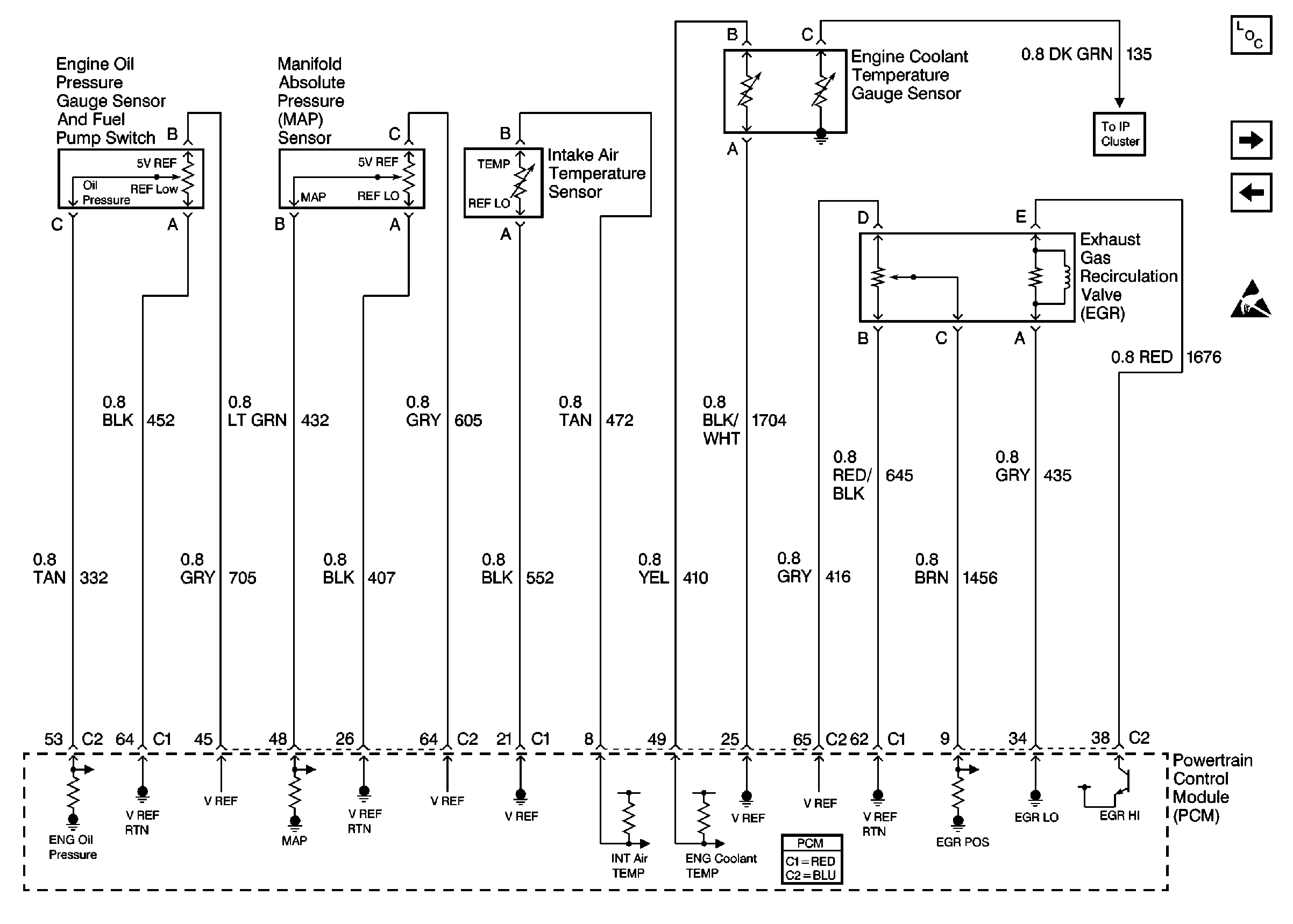Refer to
Cell 20: Engine Controls, Exhauxt Gas Recirculation Valve

Circuit Description
The Engine Oil Pressure sensor is mounted in the top rear of the engine. The Engine Oil Pressure sensor measures changes in engine oil pressure. The Engine Oil Pressure sensor has a 5 volt reference, a ground and a signal circuit.
The Engine Oil Pressure sensor changes resistance based on engine oil pressure. When the PCM senses a signal voltage lower than the normal operating range of the sensor, this DTC sets.
Conditions for Running the DTC
The engine is running.
Conditions for Setting the DTC
The Engine Oil Pressure sensor voltage is less than 0.48 volts.
Action Taken When the DTC Sets
| • | The PCM stores the DTC information into memory when the diagnostic runs and fails. |
| • | The Malfunction Indicator Lamp (MIL) will not illuminate. |
| • | The PCM records the operating conditions at the time the diagnostic fails. The PCM stores this information in the Failure Records. |
Conditions for Clearing the MIL/DTC
| • | A History DTC will clear after forty consecutive warm-up cycles, if no failures are reported by this or any other non-emission related diagnostic. |
| • | A last test failed (Current DTC) will clear when the diagnostic runs and does not fail. |
| • | Use a scan tool in order to clear the MIL/DTC. |
Diagnostic Aids:
Important: Remove any debris from the PCM\TAC module connector surfaces before servicing the PCM\TAC module. Inspect the PCM\TAC module connector gaskets when diagnosing/replacing the modules. Ensure that the gaskets are installed correctly. The gaskets prevent water intrusion into the PCM\TAC modules.
| • | The following may cause an intermittent: |
| - | Mis-routed harness. |
| - | Rubbed through wire insulation. |
| - | Broken wire inside the insulation. |
| • | The PCM 5.0 volt reference circuits are internally connected within the PCM. If all the Engine Oil sensor circuits check to be OK, inspect related 5.0 volt reference circuits. |
Test Description
The numbers below refer to the step numbers on the diagnostic table.
-
This step determines if the malfunction is present. For any test that requires probing of the PCM or any component harness connectors, use the Connector Test Adapter Kit J 35616 . Using this kit prevents damage to the harness connector terminals.
-
Using the Freeze Frame and/or Failure Records data may aid in locating an intermittent condition. If you cannot duplicate the DTC, the information included in the Freeze Frame and/or Failure Records data can help determine how many miles since the DTC set. The Fail Counter and Pass Counter can also help determine how many ignition cycles the diagnostic reported a pass and/or a fail. Operate vehicle within the same freeze frame conditions (RPM, load, vehicle speed, temperature etc.) that you observed. This will isolate when the DTC failed.
-
If the scan tool displays 5.0 volts, this indicates that the Engine Oil Pressure sensor signal, 5.0 volt reference circuit and PCM are OK.
-
If the scan tool displays 5.0 volts, this indicates that the Engine Oil Pressure sensor signal circuit and PCM are OK.
-
Disconnecting the PCM allows using the DMM J 39200 to check the continuity of the circuits. This aids in locating an open or shorted circuit.
Step | Action | Values | Yes | No | ||||||
|---|---|---|---|---|---|---|---|---|---|---|
1 | Did you perform the Powertrain On-Board Diagnostic (OBD) System Check? | -- | ||||||||
Is the Engine Oil Pressure voltage below the specified value? | 0.48 V | |||||||||
Does the scan tool indicate that this diagnostic failed this ignition? | -- | Go to Diagnostic Aids | ||||||||
Is the Engine Oil Pressure voltage near the specified value? | 5 Volts | |||||||||
Is the Engine Oil Pressure voltage at the specified value? | 5 Volts | |||||||||
Was the 5.0 volt reference circuit open or shorted to ground? | -- | |||||||||
7 |
Did the terminal require replacement? | -- | ||||||||
8 |
Was the Engine Oil Pressure signal circuit open or shorted to ground? | -- | ||||||||
9 | Check the Engine Oil Pressure sensor signal circuit for a poor connection at the PCM. Refer to Wiring Repairs in Wiring Systems. If you find a poor connection, replace the terminal. Refer to Wiring Repairs in Wiring Systems. Did the terminal require replacement? | -- | ||||||||
10 |
Important:: Before replacing the Engine Oil Pressure sensor perform the engine oil pressure check. Refer to Oil Pressure Diagnosis and Testing in Engine Mechanical. Replace the Engine Oil Pressure sensor. Refer to Fuel Pump and Engine Oil Pressure Switch Replacement . Is the action complete? | -- | -- | |||||||
11 |
Important:: Program the replacement PCM. Refer to Powertrain Control Module Replacement . Replace the PCM. Is the action complete? | -- | -- | |||||||
12 |
Does the scan tool indicate that this test ran and passed? | -- | ||||||||
13 | Select the Capture Info option and the Review Info option using the scan tool. Does the scan tool display any DTCs that you have not diagnosed? | -- | Go to the applicable DTC table | System OK |
